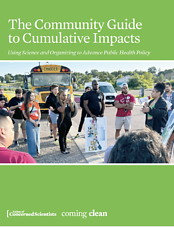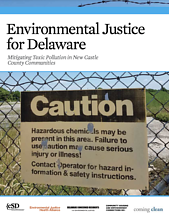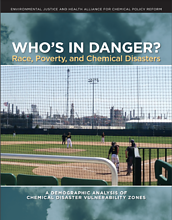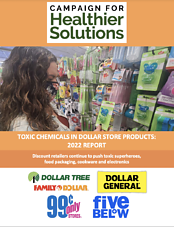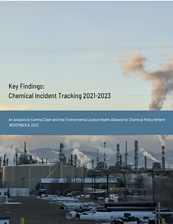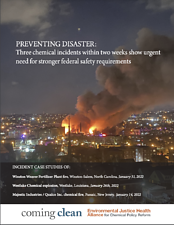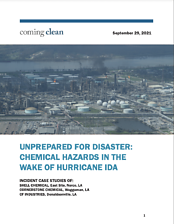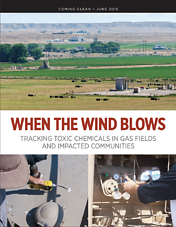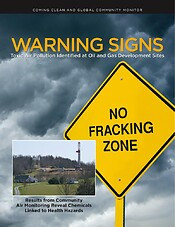-
The Community Guide to Cumulative Impacts (Coming Clean and the Union of Concerned Scientists, 2024)
The Guide is a resource to help community, statewide, and national organizing, research, and campaigns drive changes that protect us from cumulative chemical and pollution harms—especially in disproportionately impacted and overburdened communities. You can use its overview of proven strategies and tools to organize your community. You can learn from trailblazing grassroots community advocates across the United States as you introduce and advance local policies on cumulative impacts. Understanding cumulative impacts as both a concept and a policy strategy will strengthen your capacity to take action in your community or state.
-
Watered Down Justice (NRDC, EJHA, Coming Clean, 2019)
This report explores the disturbing relationship between sociodemographic characteristics—especially race—and drinking water violations. Violations increased in communities of color, low-income communities, and areas with more non-native English speakers or crowded housing conditions.
-
Environmental Justice for Delaware: Mitigating Toxic Pollution in New Castle County Communities (Union of Concerned Scientists, 2017)
This report highlights health and safety risks in seven New Castle County communities located along an industrial corridor. These communities face higher rates of cancer, respiratory illness, and proximity to hazardous facilities compared to affluent areas like Greenville, DE.
-
Life at the Fenceline: Understanding Cumulative Health Hazards in Environmental Justice Communities (EJHA, Coming Clean, 2018)
This report shows that people living near chemical facilities face increased cancer rates, respiratory illness, and limited access to healthy food. Fenceline zones are disproportionately Black, Latino, and impoverished, highlighting environmental injustice in these communities.
-
Who's in Danger: Race, Poverty and Chemical Disasters (EJHA, Coming Clean, 2014)
This report presents research showing that residents of chemical facility "vulnerability zones" are disproportionately Black or Latino and face higher poverty rates. These communities are at greater risk of chemical disasters and experience lower housing values and education levels.
-
Toxic Chemicals in Dollar Store Products (Campaign for Healthier Solutions, Ecology Center, Environmental Defence, 2022)
This product testing report found that over 50% of items purchased at major dollar stores in 2021 contained chemicals of concern. Notably, many of these items included toys and other products marketed to children that were found to contain lead, PVC, and phthalates.
-
A Day Late and a Dollar Short: Discount Retailers are Falling Behind on Safer Chemicals (Campaign for Healthier Solutions, 2015)
In 2015, we tested 164 products purchased at the four largest dollar store chains in six states. 81% of the products tested contained at least one hazardous chemical above levels of concern, including lead, phthalates, and PVC. Low-income communities and communities of colour rely on dollar stores for staples, and are already disproportionately exposed to harmful chemicals. We argue that this places a higher level of responsibility on dollar stores to ensure they are not selling toxic products.
-
Product Testing for the People: Pitfalls, Persistence, and Progress in Transforming Dollar Stores (2025)
This report is the result of a year long community-driven effort to collect, test, and screen dollar store products for chemicals of concern. The report provides safe shopping tips for families and actionable recommendations for Dollar Tree and Dollar General to expand, improve, and enforce their chemical policies, and discusses loopholes in federal law that allow companies to sell products containing chemicals of concern, showing the importance of corporate action. Highlighted products of concern purchased at Dollar Tree/Family Dollar and/or Dollar General include: “Baby Shark” baby lotion containing a formaldehyde-releasing chemical; daily moisturizer containing a chemical banned in European cosmetics; light-up children’s bracelets, plastic roses and mini candy pails containing lead; children’s products made with polyvinyl chloride or PVC, and receipts containing bisphenol-S.
Learn more about the Campaign for Healthier Solutions
-
Key Findings: Chemical Incident Tracking 2021-2023
This analysis summarizes nearly three years of hazardous chemical incident data collected by the Coalition to Prevent Chemical Disasters. Between January 1, 2021 - October 15, 2023, at least 825 chemical incidents were reported in the United States, including fires, explosions, and chemical releases, leading to nearly 200 community evacuations. Many incidents stem from the fossil fuel lifecycle.
-
Preventing Disaster: Urgent need for stronger federal safety requirements
This report profiles three chemical incidents in January 2022, urging the EPA to implement specific safety measures in its Risk Management Program to prevent future disasters.
-
Unprepared for Disaster: Chemical Hazards in the Wake of Hurricane Ida
This report highlights facilities in Louisiana that released toxic chemicals after Hurricane Ida. It recommends updates to the EPA's Risk Management Program to prevent future chemical hazards.
Learn more about our Chemical Disaster Prevention Program
-
The Chemical Industry: An Overlooked Driver of Climate Change (Darya Minovi, 2021)
This policy paper outlines how chemical production is inextricably linked to fossil fuels, providing a roadmap for plank #1 of the Louisville Charter: "Address the Significant Impacts of Chemical Production and Use on Climate Change." It highlights the need to reduce and replace fossil fuels in the chemical industry and slow plastic production to curb GHG emissions.
-
Addressing Environmental Injustice Through the Adoption of Cumulative Impacts Policies (Drs. Nicky Sheats and Ana Baptista, 2021)
This policy brief defines cumulative impacts and discusses model policies enacted in New Jersey to prevent overburdened communities from further toxic chemical exposure. It forms part of plank #2 of the Louisville Charter: "Prevent Disproportionate Exposures and Hazards, and Reduce Cumulative Impacts on Environmental Justice Communities."
-
Transforming the Chemical Industry: Safer Substitutes and Solutions for a Non-Toxic Economy (Beverley Thorpe, 2022)
This policy paper provides a roadmap for Plank #3 of the Louisville Charter: "Require Safer Substitutes and Solutions for a Non-Toxic Economy." It diagnoses fundamental problems with chemical use and production today, highlighting the chemical industry’s lack of accountability for rampant chemical pollution that is damaging the health of communities and workers, and the stability of life-supporting ecosystems. It also addresses the need for lower-hazard chemical substitutes and highlights the harm caused by chemicals such as benzene and butadiene to environmental justice communities in places like Louisville and Houston. See also this UMass Lowell webinar.
Learn more about the Louisville Charter for Safer Chemicals
-
When the Wind Blows: Tracking Toxic Chemicals in Gas Fields and Local Communities (Coming Clean, 2016)
In 2014, residents from Pavillion, Wyoming, collaborated with health experts to test the air and residents’ bodies for chemicals linked to gas production. This was the first study combining environmental sampling with biomonitoring of community members living near gas production sites.
-
Warning Signs: Toxic Air Pollution Identified at Oil and Gas Sites (Coming Clean and Global Community Monitor, 2014)
In 2012, twelve community groups from six states tested air near oil and gas sites, including areas with fracking activities. This report provided results from community air monitoring near these development sites, highlighting toxic air pollution risks.


